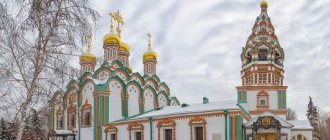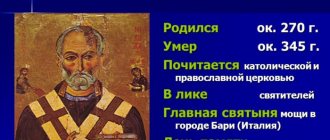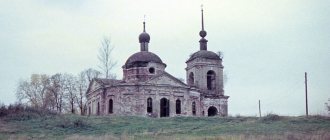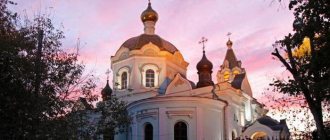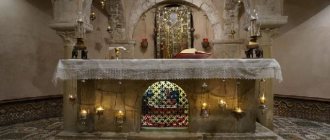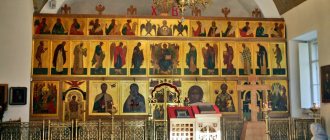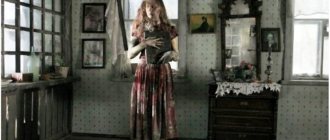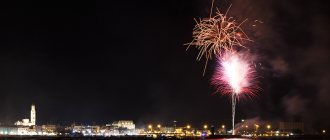The Church of St. Nicholas the Wonderworker in Khamovniki has experienced an eventful history: it has never closed or stopped working.
Today it is included in the list of architectural monuments of federal significance in Moscow. The Church of St. Nicholas the Wonderworker in Khamovniki is also called the Church of St. Nicholas, St. Nicholas-Khamovnicheskaya, St. Nicholas or St. Nicholas Church. The word “Khamovniki” itself comes from the name of the profession of the royal weavers - Khamovniki, who lived in Moscow at this address.
In contact with
Story
The first mention of the temple dates back to 1625: then it was an ordinary wooden church for local residents. But already in 1657 it was rebuilt in stone, and in 1677 it was given its full name, which has survived to this day. However, it was not preserved in its original version: 2 years later, under Tsar Fyodor Alekseevich, it was rebuilt, and in 1682 it was consecrated. After some time, the refectory and bell tower were completed.
During the Second World War with Napoleon, the church suffered , losing part of the interior. It was restored only by the middle of the 19th century. At the same time, wall paintings appeared and a fence was erected around it. Afterwards, restoration was carried out at the end of the century, in 1949 and 1972. Surprisingly, the temple remained operational all this time; even the Soviet government did not close it, much less rebuild it into household buildings. In 1912-1960, the rector was Archpriest Pavel Lepekhin.
The only “robbery” was the removal of the bells, and then the unique Latygin bell was transferred to the collection of the Historical Museum of Moscow - in 1992 it was returned to its place.
In 2008, the temple celebrated its 160th anniversary . Before this, in 2002, the Church of the Mother of God “Quick to Hear” was built in Kiselevsk, the prototype of which was the temple in Khamovniki.
Another interesting fact is connected with the name of Leo Tolstoy: the count lived in Moscow not far from the temple and was its parishioner. The church is mentioned by him in some of his works.
History of the temple
In the summer of 1990, an initiative group of 20 Orthodox Christians submitted documents to register the Orthodox community of the Russian Orthodox Church of the Moscow Patriarchate at the Church of St. Nicholas in Pyzhi. On September 27, 1990, the Moskvoretsky District Executive Committee decided to register the community. On November 13 of the same year, Archpriest Alexander Shargunov, a cleric of the Church of the Icon of the Mother of God “Joy of All Who Sorrow” on Bolshaya Ordynka, a teacher at the Moscow Theological Academy and Seminary, and an outstanding preacher, was appointed rector of the church. Three days later, on December 16, the first constituent meeting took place, at which 50 members of the Parish Assembly were elected. From among them, the Parish Council was elected, headed by its chairman, Archpriest Alexander Shargunov, and the Audit Commission.
On April 4, 1991, warrants were received for the temple, the clergy house and the guardhouse, but, despite the existence of legal grounds, the tenants did not intend to vacate the premises. The situation changed after the first prayer service in the church on May 22, 1991, on “St. Nicholas of the Veshny.” After the prayer service, a religious procession was held around the temple with sprinkling of the building. And two weeks later, an act was signed on the partial transfer of the temple premises, namely: the bell tower, the refectory and the St. Nicholas chapel - to the community of believers, after which restoration work immediately began in them.
With the blessing of Father Alexander, services in the church began almost simultaneously with the repair work. The first took place on July 11, 1991. It was an all-night vigil on the eve of the feast of the holy supreme apostles Peter and Paul. The next day, the first Divine Liturgy was served, during which all the parishioners of the revived church - 68 people - took communion. The choir sang at the services under the direction of Irina Vasilyevna Smirnova, the first regent of the temple and the creator of the church choir. After this, services were held regularly on Saturday mornings and evenings, on Sundays and holidays.
Parish life was revived simultaneously with the restoration of liturgical life. Just two months after the first service, in September 1991, a Sunday school began operating at the church, which still continues to carry out its spiritual and educational activities.
The most important event in the life of the revived parish was the first visit to the church on April 18, 1992, on Lazarus Saturday, by the Primate of the Church, His Holiness Patriarch of Moscow and All Rus' Alexy II, who, in the concelebration of Bishop Istra (now Metropolitan of Lipetsk and Zadonsk) Arseny (Epifanov), performed consecration of the St. Nicholas chapel. The Nikolo-Pyzhevsky Church became one of the first in Moscow to be consecrated by the Patriarch. The arrival of His Holiness and his blessing of the work to revive the temple provided powerful spiritual support for the continuation of liturgical life and the renovation work that had begun. They were held in the temple from 1991 to 2004 under the leadership of B.L. Altshuller. Their organization was carried out by the first head of the temple, Olga Aleksandrovna Lochagina.
The creator of two iconostasis and all the decorative decoration of the temple is the icon painter Irina Vasilievna Klimenko. The work was carried out with a short break from 1992 to 2002: the three-tier Nikolsky - from 1992 to 1995, the five-tier Blagoveshchensky - from 1995 to 2002. The models for their solution were, respectively, the Trinity iconostasis of the Trinity-Sergius Lavra and the Annunciation iconostasis of the Moscow Kremlin.
The main content of the Nikolsky iconostasis is the Cross and the Resurrection. It is reflected in icons and ubruses (the Calvary Cross, the Prudent Thief, the Descent into Hell, the Tree of Life, a flourishing cross, a peacock pecking a bunch of grapes). Hidden here is the fate of Russia, its holiness, fall, transformation through repentance and the hope of the Resurrection.
The symbol of the Russian cross was the image of the martyr Tsar Nicholas II. It was originally conceived by the icon painter as part of the saints of the St. Nicholas iconostasis. Here there was complete unanimity with Father Alexander, who blessed the painting of the image. At that time it seemed madness or impudence, since no one had yet thought about glorifying the Tsar in Russia. The icon was painted in 1994 and became one of the first attempts at iconographic understanding of the image of Tsar Nicholas II. However, until the canonization of the royal family, the image was placed in the Annunciation altar. In 2000, after the glorification, the icon of the martyr king was again put in its place, and the iconostasis received a holistic meaning.
The iconostasis emphasizes Russian holiness. In addition to the canonically obligatory images of deisis (the Mother of God, John the Baptist, Archangel Michael, Archangel Gabriel, the apostles Peter and Paul), Russian saints predominate - St. Sergius of Radonezh and Seraphim of Sarov, St. Peter of Moscow, St. Basil the Blessed. In the local ranks is Tsar-martyr Nicholas II. The monarchical theme, the union of Church and state (the Byzantine “symphony of powers”) completes the iconostasis in the form of double-headed eagles, and the crosses on the domes of the temple are crowned with royal crowns.
The theme of the Cross also carried over into the Annunciation iconostasis with the depiction in the festive row of the Passion of Christ: the Crucifixion, the Descent from the Cross, the Entombment, as well as the holy Patriarch Tikhon and the Holy Martyr Grand Duchess Elizabeth in the local row. This united both iconostases with the main meaning - a response to personal cross-bearing to the Calvary Cross.
The main content of the iconostasis of the Annunciation chapel is the Incarnation. It is filled with the gospel of the holy righteous Joachim, holy righteous Anna and the Blessed Virgin. “The Annunciation” with the life of the Most Holy Theotokos (a copy of the Stroganov icon of the late 16th century) and the hymnographic icon “Rejoices in You” are the main dominant features of the space of this main part of the temple, which create a feeling of the jubilant spirit of life, eternal spring. Therefore, in this small space on the walls only images of the Mother of God were placed, which polyphonically reveal the theme of the iconostasis as entry into heaven, as “the main thing of our salvation.” In the Deisis there is already this emphasis in the images of the hymnographers and hymns of St. John of Damascus and Cosmas of Maium and the first icon painter of the Mother of God, the Apostle Evangelist Luke.
In 1993, His Holiness Patriarch Alexy II issued an antimension to the church and blessed the consecration by the small priestly order of the throne in honor of the Hieromartyr Vladimir, Metropolitan of Kiev, and all the new martyrs and confessors of Russia, who became one of the first in Moscow and in Russia. It is placed in the altar of the St. Nicholas chapel and is attached.
The holy royal martyrs are especially revered in the temple. Archpriest Alexander Shargunov played a huge role in their canonization. In numerous sermons in church and in speeches on the Radonezh radio station, he deeply revealed the spiritual meaning of the feat of the royal passion-bearers and exposed the slander against them. For a long time, Father Alexander was engaged in collecting evidence of miracles through prayers to the royal family, which resulted in six collections published by him in 1995–1999, which largely served to bring her canonization closer at the Council of Bishops in 2000. In 2001, the final two-volume work “Miracles of the Royal Martyrs” was published. In 2013, on the occasion of the 400th anniversary of the House of Romanov, Father Alexander’s book “Tsar” was published with the author’s theological reflections on the meaning of the Orthodox monarchy and the feat of the last Russian Tsar. In 2021, on the 100th anniversary of the murder of the royal family, the book was republished.
The temple contains several shrines associated with the royal family. For a long time, there was an all-Russian shrine here - the myrrh-streaming, fragrant image of the holy martyr Tsar Nicholas II. Knowing about Archpriest Alexander Shargunov’s deep veneration for the holy royal passion-bearers, the owner of the icon, Moscow doctor Oleg Ivanovich Belchenko, in February 1999, shortly before the canonization of the royal family, chose the St. Nicholas-Pyzhevsky Church as its permanent residence. Currently, there is a copy of it in the temple. In 2000, an icon of the royal family with a milk tooth of one of the younger royal children was transferred to the temple from France, which was preserved by the tutor of Tsarevich Alexei and the French teacher of the Grand Duchesses, Pierre Gilliard.
Since 1994, Father Alexander has headed the public committee “For the Moral Revival of the Fatherland,” created on the initiative of a group of clergy and laity of the Russian Orthodox Church with the aim of fighting against immorality, debauchery and Satanism, which since the beginning of “perestroika” have been implanted in society through the media with the connivance of government bodies. The movement received the blessing of His Holiness Patriarch of Moscow and All Rus' Alexy II and the support of Metropolitan of St. Petersburg and Ladoga John (Snychev). The committee includes many Orthodox clergy, scientists, cultural and artistic figures.
On September 27, 2013, on the feast of the Exaltation of the Honorable and Life-Giving Cross of the Lord, His Holiness Patriarch Kirill of Moscow and All Rus' performed the long-awaited rite of the great consecration of the Annunciation chapel of the St. Nicholas Pyzhevsky Church and the Divine Liturgy in the newly consecrated temple. Concelebrating with His Holiness was a council of bishops: Metropolitan of Saransk and Mordovia (now St. Petersburg and Ladoga) Barsanuphius (Sudakov), Metropolitan of Tambov and Rasskazovsky Feodosius (Vasnev), Archbishop of Istra (now Metropolitan of Lipetsk and Zadonsk) Arseny (Epifanov), Archbishop (now Metropolitan ) Tobolsk and Tyumen Dimitry (Kapalin), Bishop of Solnechnogorsk (now Metropolitan of Singapore and Southeast Asia) Sergius (Chashin) and Bishop of Uvarov and Kirsanovsky Ignatius (Rumyantsev).
***
I would like to conclude the brief story about the temple with a poem by Lyudmila Igorevna Kryukova, a scientist-economist, philologist, poet, teacher at the Orthodox St. Tikhon’s Theological Institute, member of the Public Committee “For the Moral Revival of the Fatherland,” director of the Sunday school at the Church of the Nine Martyrs of Kizi, who loved “ Nikola in Pyzhi."
On October 27, 2000, she accepted martyrdom. Here the walls will help you to pray, And the eagles on the altar gates. Here the soul begins to feel ashamed For its wandering in the dark. And for the sleep in anticipation of Golgotha, For the shameful death of the country, For its inept stanzas, Which are full of powerless sadness. Here the soul in front of the Royal icon Comprehends itself to the bottom .In repentant tears and bows, she comes to life from her sins. And remembering the former glory of the Fatherland, she rises from the ashes. Before our Lady Sovereign, she quietly makes vows in her heart. And then unearthly grace from the Baby in Her hands covers the Church of St. Nicholas on Bolshaya Ordynka in Pyzhi with the grace of God
Appearance and decoration
The temple is made in the Russian patterned style, which was popular at that time and came from Yaroslavl.
This is a snow-white church with 5 domes with a green roof and multi-colored decorations; it is connected to a hipped bell tower by a refectory. The church looks very “folk” : it looks both modest and elegant, evoking associations with peasant festive clothes. Its architectural uniqueness was recognized even in the USSR - it was not for nothing that the building was not touched and was even restored.
Inside, paintings from the 18th century (more precisely, from the 1840s) have been preserved: all the walls, columns and ceiling are decorated with them. In the images you can see the earthly life of Christ, scenes from the Old Testament, seraphim and many other saints. The iconostasis is four-tiered and is crowned with a Crucifix. It is made in blue and gold colors.
Used materials
- Page of the portal “Russian Orthodoxy”
- Page of the “People's Catalog of Orthodox Architecture”
[1] “Decree U-02/1 of January 9, 2021 // to Bishop Tikhon of Podolsk,” official website of the Moscow City Diocese, January 11, 2018,
[2] “Decree No. U-02/42 of February 5, 2021 // to Archpriest Andrei Ovchinnikov,” official website of the Moscow City Diocese, February 8, 2021,
[3] “Decree No. U-02/124 of July 26, 2021 // to Archpriest Andrei Ovchinnikov,” official website of the Moscow City Diocese, July 30, 2021,
In honor of whom is the temple
Saint Nicholas, in whose honor the temple received its name, was a Byzantine bishop in the 3rd-4th century . He is the patron of travelers, orphans and prisoners. The saint became the prototype of Santa Claus, and the story from his life about the gift of a dowry to 3 poor girls turned into a tradition of Christmas gifts.
In Rus', Nicholas is one of the most significant and revered saints: the number of churches dedicated to him is second only to the churches of the Virgin Mary. HE is considered the eldest among all the saints, and in some traditions he is even included in the Trinity: Christ - Our Lady - Nicholas.
In the Khamovnichesky Church in Moscow there are no icons dedicated to the saint - its name is more “fashionable”.
Main shrine
The main shrine of the Church of St. Nicholas the Wonderworker is the icon of the Mother of God “Sporuchnitsa sinners” (Guarantor for sinners before the Lord, mediator between God and people).
The image was created in the middle of the 18th century in the Odrino-Nikolaevsky monastery (Oryol province). The icon was immediately noted for several healings, including from cholera, the epidemic of which was breaking out at that time. The first miracles occurred in the year of writing: the epileptic young son of a local resident was healed (she saw the icon in a dream), the paralyzed son of a landowner rose to his feet, and a 3-year-old merchant’s daughter began to see. All the miracles occurred almost at the same time, after which the icon was transferred from the church near the gate to the Church of St. Nicholas the Wonderworker.
In the 20s of the twentieth century, the monastery was destroyed , the icons were distributed to local residents. “The mate of sinners” went to a resident of the village of Staroye (today it is part of the Oryol region). In the 70s, the image was given to parishioner Raisa, who in 1994 went with him to a monastery near Odessa and took monastic vows there. But a year later, Raisa returned and settled in the Nikolo-Orda monastery, but the icon remained on the territory of Ukraine.
Schemamonk Macarius from Optina Pustyn took charge of her return. Returning the image turned out to be a difficult matter: firstly, Macarius himself was disabled with paralyzed legs, and secondly, the icon was in a private collection. But still, in 1996, the “Helper of Sinners” returned to the monastery.
However, in the Church of St. Nicholas the Wonderworker there is not the original icon, but a copy of it , however, no less miraculous. 3 years after the original icon was painted, it was sent to Moscow to create a chasuble. “Sporuchnitsa” spent this time in the house of Lieutenant Colonel Boncheskul. After the icon was returned to the monastery, a copy of it was sent to the lieutenant colonel in gratitude.
The owner of the house placed it in the home iconostasis, but soon the family noticed an unusual reflection on the icon, and after a while an oily liquid began to come out. They collected it and anointed several sick people, who were immediately healed. Afterwards, other sufferers began to arrive on the list.
After 2 years, the lieutenant colonel handed over a copy to the Church of St. Nicholas the Wonderworker. The liquid continued to ooze: the deacon wiped it off with paper, which he gave to the parishioners. And although the myrrh-streaming soon stopped, visions of stars began to appear in the altar.
Today there is a list of officially recorded miracles and healings performed by the icon, some of which happened to pagans and non-believers.
Other shrines are:
- List of the Smolensk Icon of the Mother of God, made in the 17th century;
- Icon of St. Alexis (late 17th century);
- Icon of the martyr John the Warrior (XVIII century).
Main temple shrines
In addition to the prayer address to St. Nicholas the Wonderworker, other shrines are also venerated in the temple. This:
- Icon of the Mother of God, Helper of Sinners (list dated 1848).
- Icon of St. Alexis (1688).
- Icon of the Mother of God of Smolensk (the list dates back to the 17th century).
- Icon of the martyr John the Warrior (18th century).
Church of St. Nicholas in Khamovniki
When you come to church, you can prayerfully address both these and all Orthodox saints.
Contacts and service schedule
- Address: Moscow, st. Lev Tolstoy, building 2, index 119021;
- Nearest metro: “Park Kultury” (exit to Ostozhenka Street and further along Ostozhenka to the intersection with Lev Tolstoy Street) or “Frunzenskaya” (exit towards the Moscow Youth Palace and along Komsomolsky Prospekt to Tolstoy Street);
- Opening hours: daily from 7:30 to 20:00, on Sunday – from 6:30 to 20:00;
- Temple phone number; phone number of the priest on duty - 8-925-910-20-17;
- Website: https://nikola-khamovniki.ru; email: [email protected] ;
- Current rector (since 2009): Tikhon, Bishop of Podolsk (Alexander Viktorovich Zaitsev).
The schedule of services can be viewed on the temple website. On weekdays and Saturdays, parishioners can attend:
- 7:45 – confession;
- 8:00 – liturgy;
- 17:00 - Vespers and Matins, on Saturday - at the all-night vigil.
On Sunday the schedule changes:
- 7:00 – liturgy;
- 10:00 – liturgy;
- 17:00 – Vespers and Matins.
Depending on church holidays, the schedule may be changed.
Schedule of services in the Church of St. Nicholas
Strictly speaking, a church day begins in the evening of the previous date and ends in the afternoon.
In the Church of St. Nicholas, both evening and daytime services are performed daily:
- daily Vespers begins at 17.00;
- daily liturgy - at 8.00;
- the exception is Sundays and days of great church holidays - then the liturgy is served both from 7.00 and 10.00;
- on Tuesdays, Vespers is dedicated to the icon of the Most Holy Theotokos, Helper of Sinners;
- on Thursdays Vespers is dedicated to St. Nicholas;
- On Sundays, not only Vespers, but also Matins are served to the Savior.
Advice! The schedule of services of this temple can be found on the official website of the temple: nikola-khamovniki.ru. There you can also see messages about changes in the schedule, for example, in connection with the arrival of the Patriarch and other bishops.
Temple activities
St. Nicholas Church is not limited to holding services: today it operates a Sunday school and a youth group.
The school has been operating for more than 20 years, teaching children aged 6-16 years in 4 groups. Recruitment takes place at the beginning of the school year, classes begin with the Divine Liturgy. Subsequently, students not only study electives, but also participate in confession and communion. The following classes are held at the school address:
- Religious: the basics of morality, the law of God, the lives of saints, the history of the church, etc.;
- Musical: choral and church singing, folk music;
- Artistic: creative workshop, applied art.
Additional classes are held on Saturdays:
- Circle of icon painting;
- Church choir;
- Folk instruments and folk music;
- English with a religious twist.
For children 2-5 years old there are separate music and arts and crafts classes. There is also a youth club in the temple: it is aimed at communication, watching thematic films, visiting exhibitions, pilgrimages, and staging performances.
There is also a social service at the temple address . She helps people in difficult life situations, helps with housing, treatment and maintenance. St. Nicholas Church is involved in the work:
- With the regional society of disabled people;
- With a social service center, which registers low-income and large families, single mothers, single pensioners;
- At the State Scientific Center for Social and Forensic Psychiatry named after. Serbsky: church employees carry out pastoral and social work.
Every Sunday from 12 to 15 o'clock a reception for parishioners is held at the temple address; those who wish can also receive help by telephone from the priest on duty by telephone.
Results
The Church of St. Nicholas the Wonderworker in Khamovniki appeared more than 3 centuries ago , when a stone church was erected at the address of the local wooden church. It was not closed during the Soviet Union and has retained not only its appearance, but also its interior decoration. Today the church conducts educational work among children and youth and cooperates with social services.
Church of St. Nicholas the Wonderworker
